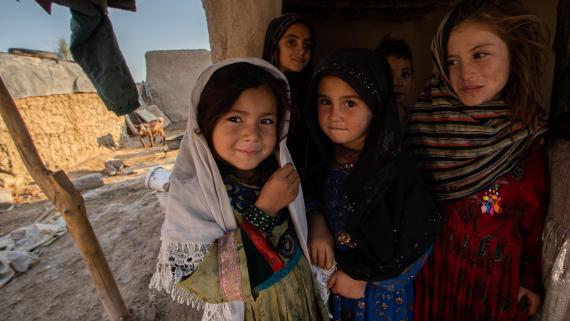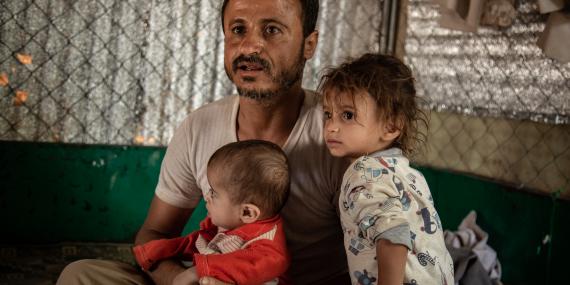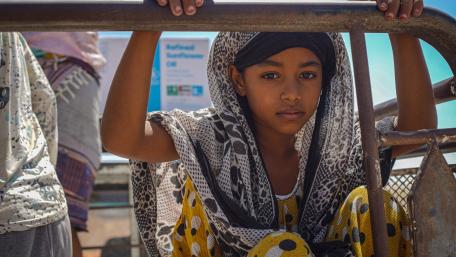Mareb, Yemen
This father lives with his family in an IDP camp in Al-Jalal in Mareb. He and his family fled fighting initially to Al Jawf. After Al Jawf was attacked, they fled to Mareb. A mobile health team recently discovered that his two daughters are severely malnourished. He said: “These five years of war have had severe effects on us. We're tired, exhausted of this situation and living conditions. If there was no war, we could have been in our homes now. I don't know how or when my daughters developed malnutrition, but this is most likely because of these difficult living conditions." UNICEF/Gabreez
The last decade saw the highest ever number of people internally displaced by conflict and violence: 79 million people were displaced between 2010–2019.
Internally displaced persons (IDPs) continue to make up the majority of people fleeing conflict, violence and natural disasters, while durable solutions remain elusive. Many of these people remain in protracted displacement. In 2019 alone, disasters caused 24.9 million new displacements, while 8.5 million people were newly displaced by conflict and violence. By the end of 2019, there were an estimated 50.8 million new and existing IDPs, including a record 45.7 million people displaced due to conflict and violence. Preliminary figures show that between January and June 2020, there were a further 14.6 million new displacements across 127 countries and territories. Conflict and violence triggered 4.8 million displacements, and disasters triggered 9.8 million. Most conflict-induced displacements took place in Africa and the Middle East, while the majority of disaster-induced displacements occurred in Asia.
The 2020 half-year figures for Cameroon, Mozambique, Niger and Somalia are already higher than those for the whole of 2019. Burkina Faso, the Democratic Republic of the Congo (DRC) and Syria also recorded a significant number of conflict-induced displacements. As such, the total conflict-related displacement figures for 2020 are likely to be even higher than for 2019.
New internal displacements (2019)
The number of refugees doubled from 10 million in 2010 to 20.4 million in 2019. More than two thirds of displacements across borders at the end of 2019 originated in just five countries: Afghanistan, Myanmar, South Sudan, Syria and Venezuela. Developing countries host 85 per cent of refugees. As crises become increasingly complex and protracted, fewer refugees can return home. Only 3.9 million refugees returned between 2010 and 2019 compared to nearly 10 million the previous decade.
Forcibly displaced people (2010-2020)
IDPs and refugees are particularly vulnerable to COVID-19 and its secondary effects. The risk of COVID-19 outbreaks in camp or camp-like settings remains real. This is due to crowded living conditions and limited access to water, sanitation and health facilities. Movement restrictions have impeded voluntary returns or escape from unsafe areas, and asylum seekers face particular challenges while access to asylum procedures has been hindered in some countries. Stigmatization and discrimination against forcibly displaced people are on the rise. And the heightened protection risks facing IDPs and refugees in normal times have been exacerbated under COVID-19, especially for women and girls. The INFORM COVID-19 Risk Index shows that 6 of the 10 countries most at-risk of COVID-19 host a combined population of 17.7 million IDPs.
Forcibly displaced people by conflict and natural disasters (2019)
The direct health impacts of COVID-19 will be dwarfed by the indirect ones. These include disruptions to immunization campaigns and essential health services, rising food insecurity and the economic fallout, all of which will hit forcibly displaced persons particularly hard, depriving many of their livelihoods and jobs, particularly in the informal economy. According to a survey of IDPs and refugees in 14 countries, 77 per cent had lost a job or income since March 2020, 71 per cent reported difficulty paying rent or other basic housing costs (many had been evicted) and 70 per cent had reduced the number of meals for their household.
Stranded migrants

The extraordinary mobility and travel restrictions of 2020 have exacerbated the precarious situations and vulnerabilities of migrant populations. As of July 2020, an estimated 2.75 million migrants were stranded, with COVID-19-related mobility restrictions impeding their intended movements. Many face deportation as their visas and permits expire, as well as homelessness, stigmatization and detention in overcrowded facilities without appropriate medical care or self-isolation facilities. Those stranded may also be more vulnerable to exploitation, including trafficking in persons and – out of desperation – taking up employment in conditions with increased exposure to COVID-19. As of 28 September 2020, 218 countries, territories and areas have imposed entry restrictions. Medical measures are the most common limitation to entry, representing 54 per cent of all possible restrictions. Deportations of stranded and irregular migrants can overwhelm weak public health systems in receiving countries. Several Governments have implement-ed commendable measures to support stranded migrants including blanket visa extensions, access to medical facilities and basic needs – though stranded migrants will continue to require protection and other assistance into 2021.
OCHA/Charlotte CansForcibly displaced persons’ vulnerability to COVID-19 calls for their inclusion in national COVID-19 responses, a heightened focus on efforts to address gender-based violence (GBV) among displaced populations, advocacy to combat stigmatization and discrimination, and a stop to forced returns to insecure places of origin.
Most importantly, COVID-19 reinforces the imperative to advance durable solutions for forcibly displaced persons, which will reduce underlying vulnerabilities. The UN Secretary-General’s High-Level Panel on Internal Displacement, which held its first meeting in February 2020, is tasked to provide the Secretary-General with innovative and concrete recommendations for Member States, the UN, NGOs and other stakeholders to better prevent, respond to and achieve solutions for internal displacement. The Panel’s report is planned for September 2021.
Further reading
Source: IASC
Source: UNHCR
Source: IDMC
Source: IOM
References
- Internal Displacement Monitoring Centre, Global Report on Internal Displacement, April 2020, p. 11. Five countries – Afghanistan, Colombia, DRC, Syria and Yemen – accounted for more than half the total of IDPs displaced by conflict and violence.
- Internal Displacement Monitoring Centre, Global Report on Internal Displacement, April 2020, p. 1.
- Internal Displacement Monitoring Centre, Internal displacement 2020: mid-year update, 23 September 2020
- Internal Displacement Monitoring Centre, Internal displacement 2020: mid-year update, 23 September 2020
- Figures are based on UNCHR’s Global Trends: Forced Displacement in 2019 and do not reflect the approximate 5 million Palestinian refugees under UNRWA’s mandate.
- UNHCR, Global Trends: Forced Displacement in 2019, 18 June 2020, p. 22. The three most common countries of asylum hosted people almost exclusively from one single country: Turkey, with 3.6 million Syrians; Colombia, with 1.8 million Venezuelans; and Pakistan, with 1.4 million Afghans.
- UNHCR, Global Trends: Forced Displacement in 2019, 18 June 2020, pp. 11—12.
- UN Secretary-General, Policy Brief: COVID-19 and People on the Move, June 2020, p. 11.
- INFORM COVID-19 Risk Index identifies countries at risk from health and humanitarian impacts of COVID-19 that could overwhelm national response capacity, and therefore lead to a need for additional international assistance.
- UN Secretary-General, Policy Brief: COVID-19 and People on the Move, June 2020, p. 11.
- Norwegian Refugee Council (NRC), Downward Spiral: The economic impact of COVID-19 on refugees and displaced people September 2020
- IOM, COVID-19 Impact on Stranded Migrants, 30 September 2020; IOM, Issue Brief: COVID-19 and Stranded Migrants, 2 June 2020, p. 1; OCHA, Global Humanitarian Response Plan, July Update 2020.
- IOM, Global Mobility Restriction Overview, 28 September 2020





